According to a 2015 report in Restaurant Business magazine, seafood is becoming increasingly popular in the fast casual setting. Part of that growth is that consumers opted eat more fish over health concerns. In fact, according to data from the market-research company Technomic Inc., 72 percent of people cited health as the primary reason for the shift to seafood.
Even if you’re a culinary graduate who isn’t in the fast casual business, you may still want to take advantage of people’s growing interest in all things seafood. However, buying fish can be an art, and you have to know exactly what you’re looking for to get the freshest fish possible.
Here are a few handy tips when it comes to buying and selecting fish for your restaurant or eatery:

1. Keep them open
Clams or mussels are a tasty seafood treat often eaten as an appetizer. As The Fresh Market explained, either one should be purchased while still alive, which assures the greatest possible freshness. You can tell if a clam or mussel is still alive if the shell is closed tightly. If you tap an open clam or mussel and it closes its lid, then it’s also still kicking. You may also note a slightly sweet smell emanating from the clam or mussel. After they’re purchased, it’s important to store them on ice right away, preferably between 34 and 40 degrees Fahrenheit. You also want to buy crab while it’s still alive, as the meat spoils fairly quickly. The freshest crab usually still have plenty of leg movement.
2. The eyes are the window
Buying whole fish is not only a great value, but offers more of the fish to cook with. Whenever you buying an entire flounder or mackerel, though, Chef’s Steps advised checking the state of the eyes. If you want truly fresh fish, you want the eyes to be plump and wet, with little to no clouding. The eyes are often the first to go when the fish begins to deteriorate, and murky looking eyes are indicative of foul fish. Similarly, the eyes may begun to sink in or shrivel, and that means the fish is no longer viable for eating.
3. Get hands-on with the fish
As important as the eyes are to revealing a fish’s freshness, Chef’s Steps mentioned that you should spend just as much time checking the rest of your salmon or tuna. Take a few minutes to poke the fish; you want to feel cold, wet flesh that isn’t sticky. The flesh should spring back within a few seconds of making contact. From the skin, move on to the gills. As a rule, brighter colors mean fresher fish, but you should also make sure the gills aren’t overly slimy. Same goes for the scales – the freshest fish have the shiniest scales. However, soft scales are a sign of old fish, and you want them to be firm to the touch. If you’re ever unsure, ask your local fishmonger for help.
4. Follow your nose
Whether you’re buying mackerel, crabs, oysters or anything else aquatic, you can and should always rely on your nose. As Asian Recipe pointed out, there are several key smells. For instance, fish filets will only smell bad if they’ve already spoiled; otherwise, there should only be mild odor. Not only do clams and mussels smell vaguely sweet, but the same can be said for most other forms of shellfish, with comparisons made to a “fresh sea breeze.” Raw shrimp meat, meanwhile, has a much more mild odor, though visual signs (like blackened edges or random spotting) are usually more reliable signs of spoiling.

